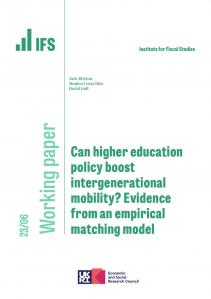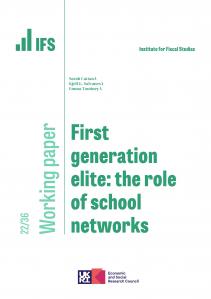The ongoing COVID-19 crisis poses a significant financial threat to the UK higher education sector. Universities will experience large income losses from falls in student enrolment, especially of international students, as well as lockdown-related losses of income from student accommodation and conference and catering operations. In addition, the sector faces financial losses on long-term investments and from increases in the deficits of university-sponsored pension schemes. While the higher education sector as a whole is well placed to shoulder these losses, they could cause serious financial problems for individual institutions, including – in the extreme – insolvency.
New analysis, from researchers at the Institute for Fiscal Studies and funded by the Nuffield Foundation, shows that:
- The total size of the university sector’s losses from the COVID-19 pandemic is highly uncertain: we estimate that long-run losses could come in anywhere between £3 billion and £19 billion, or between 7.5% and nearly half of the sector’s overall income in one year.
- Our central estimate of the total long-run losses for the university sector is £11 billion, or more than a quarter of income in one year. More than half of these losses come from a combination of falls in international student enrolments this year and an increase in balance sheet provisions relating to pension deficits.
- Large sector-level losses mask substantial differences between institutions. In general, institutions with a large share of international students and those with substantial pension obligations will face the biggest falls in income or increases in costs. These tend to be higher-ranking universities, postgraduate-only institutions or prestigious arts schools. While these institutions are relatively well placed to attract more UK students in response to falls in international enrolments, they will be constrained by recently introduced student number caps.
- But it is not the institutions with the largest COVID-related losses that are at the greatest risk of insolvency. Rather it is those, generally less prestigious, institutions that entered the crisis in a weak financial position and with little in the way of net assets, which are at greatest risk. Many of the institutions with the largest predicted losses from COVID-19 were highly profitable before the crisis and have substantial financial reserves.
- In our central scenario, 13 universities educating around 5% of students would end up with negative reserves and thus may not be viable in the long run without a government bailout or debt restructuring. A targeted bailout aimed at keeping these institutions afloat could cost just £140 million.
- Of course, bailout packages may be aimed at doing a lot more than simply preventing insolvency. But government will certainly need to be clear about the aims of any such package. More widespread and less targeted packages as proposed by some in the university sector could cost billions of pounds without providing much support to those institutions most at risk of going under.
Ben Waltmann, a Research Economist at IFS, said:
‘With around £45 billion in reserves and an annual surplus of around £2 billion before the crisis, the university sector as a whole should be able to cope with substantial COVID-related losses. However, some universities were already in a weak financial position before the crisis hit. For around a dozen of these institutions, insolvency is likely to become a very real prospect without a government bailout.’
Elaine Drayton, a Research Economist at IFS, said:
‘If the government wanted to avoid university insolvencies, by far the cheapest option would be a targeted bailout, which may cost just £140 million. However, rescuing failing institutions may weaken incentives for others to manage their finances prudently in the future. General increases in research funding avoid this problem but are unlikely to help the institutions that are most at risk, as few of them are research-active.’
Josh Hillman, Director of Education at the Nuffield Foundation said:
'In addition to showing the risk of insolvency for some higher education institutions, this report highlights the role that more general reforms could play to help alleviate the financial pressures faced by the higher education sector. For example, by implementing the recommendation from the Augur Review to introduce a lifelong learning loan allowance for tuition fees that would encourage enrolment in higher education courses below degree level, which would help less selective universities that offer such courses and may also enable people who have lost their jobs as a result of COVID-19 to reskill.'










